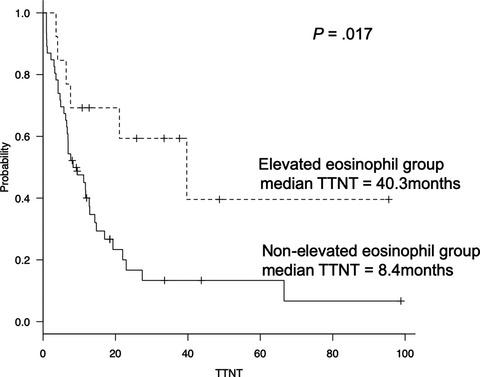当前位置:
X-MOL 学术
›
Cancer Med.
›
论文详情
Our official English website, www.x-mol.net, welcomes your
feedback! (Note: you will need to create a separate account there.)
Elevated eosinophil level predicted long time to next treatment in relapsed or refractory myeloma patients treated with lenalidomide.
Cancer Medicine ( IF 2.9 ) Pub Date : 2020-01-16 , DOI: 10.1002/cam4.2828 Kazuhito Suzuki 1, 2 , Kaichi Nishiwaki 1, 2 , Tadahiro Gunji 1 , Mitsuji Katori 1, 2 , Hidekazu Masuoka 1, 2 , Shingo Yano 1
Cancer Medicine ( IF 2.9 ) Pub Date : 2020-01-16 , DOI: 10.1002/cam4.2828 Kazuhito Suzuki 1, 2 , Kaichi Nishiwaki 1, 2 , Tadahiro Gunji 1 , Mitsuji Katori 1, 2 , Hidekazu Masuoka 1, 2 , Shingo Yano 1
Affiliation

|
Lenalidomide is an immunomodulatory drug that is administered commonly in patients with relapsed or refractory multiple myeloma (RRMM). Eosinophils have immunological functions, for instance, in allergic diseases and asthma. The purpose of this study was to investigate the clinical significance of elevated eosinophil levels in patients with RRMM treated with lenalidomide. A total of 59 patients were included. Elevated eosinophil level was defined as an increase in the eosinophil count of ≥250/µL from the eosinophil count on day 1 during the first cycle. The percentage of patients with elevated eosinophil levels was 22.0%. The overall response ratio in the elevated eosinophil group and nonelevated eosinophil group was 84.6% and 63.0% (P = .189), respectively. The median time to next treatment (TTNT) in the elevated eosinophil group was significantly longer than that in the nonelevated group (40.3 months vs 8.4 months; P = .017). Additionally, TTNT in the elevated eosinophil group with partial response (PR) or better was significantly longer than that in the nonelevated eosinophil group with PR or better (40.3 months vs 11.9 months; P = .021). We concluded that elevated eosinophil levels were frequently observed and might predict a longer TTNT in patients with RRMM treated with lenalidomide.
中文翻译:

来那度胺治疗的复发或难治性骨髓瘤患者的嗜酸性粒细胞水平升高预示着下次治疗的时间较长。
来那度胺是一种免疫调节药物,通常在复发或难治性多发性骨髓瘤(RRMM)患者中使用。嗜酸性粒细胞具有免疫功能,例如在过敏性疾病和哮喘中。这项研究的目的是调查来那度胺治疗的RRMM患者嗜酸性粒细胞水平升高的临床意义。总共包括59名患者。嗜酸性粒细胞水平升高的定义是:在第一个周期的第1天,嗜酸性粒细胞计数比第1天的嗜酸性粒细胞计数增加≥250/ µL。嗜酸性粒细胞水平升高的患者百分比为22.0%。升高的嗜酸性粒细胞组和未升高的嗜酸性粒细胞组的总应答率分别为84.6%和63.0%(P = .189)。升高的嗜酸性粒细胞组中位患者下次治疗的中位时间(TTNT)明显高于未升高的组(40.3个月vs 8.4个月; P = .017)。此外,具有部分反应(PR)或更高反应的嗜酸性粒细胞升高组的TTNT明显高于具有PR或更好的非升高嗜酸性粒细胞组(40.3个月对11.9个月; P = .021)。我们得出的结论是,经常观察到嗜酸性粒细胞水平升高,并可能预示来那度胺治疗的RRMM患者的TTNT更长。
更新日期:2020-01-17
中文翻译:

来那度胺治疗的复发或难治性骨髓瘤患者的嗜酸性粒细胞水平升高预示着下次治疗的时间较长。
来那度胺是一种免疫调节药物,通常在复发或难治性多发性骨髓瘤(RRMM)患者中使用。嗜酸性粒细胞具有免疫功能,例如在过敏性疾病和哮喘中。这项研究的目的是调查来那度胺治疗的RRMM患者嗜酸性粒细胞水平升高的临床意义。总共包括59名患者。嗜酸性粒细胞水平升高的定义是:在第一个周期的第1天,嗜酸性粒细胞计数比第1天的嗜酸性粒细胞计数增加≥250/ µL。嗜酸性粒细胞水平升高的患者百分比为22.0%。升高的嗜酸性粒细胞组和未升高的嗜酸性粒细胞组的总应答率分别为84.6%和63.0%(P = .189)。升高的嗜酸性粒细胞组中位患者下次治疗的中位时间(TTNT)明显高于未升高的组(40.3个月vs 8.4个月; P = .017)。此外,具有部分反应(PR)或更高反应的嗜酸性粒细胞升高组的TTNT明显高于具有PR或更好的非升高嗜酸性粒细胞组(40.3个月对11.9个月; P = .021)。我们得出的结论是,经常观察到嗜酸性粒细胞水平升高,并可能预示来那度胺治疗的RRMM患者的TTNT更长。











































 京公网安备 11010802027423号
京公网安备 11010802027423号